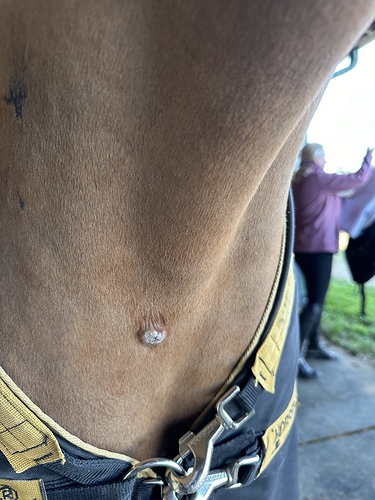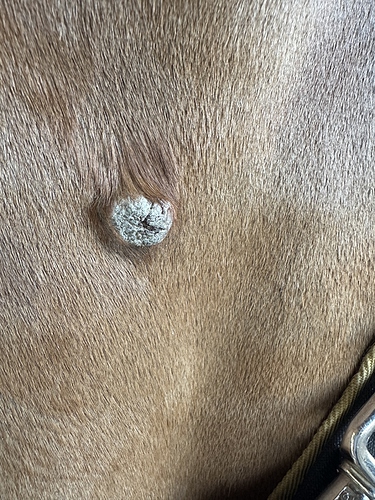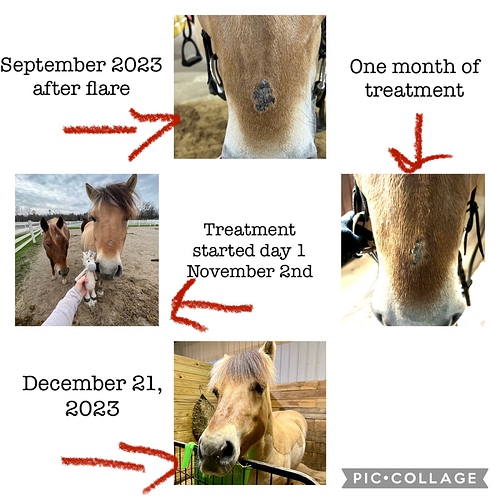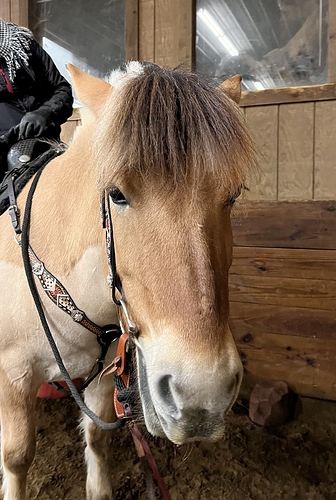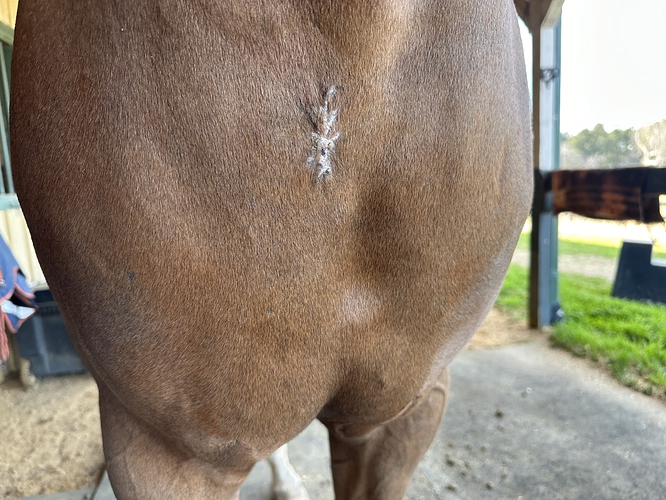I have perused other sarcoid threads on here but hoping for some updated news. Horse had a small pinhead bump in the middle of his chest at the end of the summer but it has now grown to about a nickel sized sarcoid. Flat, sort of dry but never been weepy, bloody or oozy. No pain and just cosmetic at this point! Anyone have success with having this type surgically removed?
I was researching sarcoids because my horse may/may not have one. My vet is for chemo type treatment rather than surgery because of location (on barrel, not much skin to suture for surgery). And everything I read seemed like chemo was the best approach, and surgery was less successful.
(Mine does not look like a sarcoid, just a flat hairless spot for a year, but after applying Panalog, it has grown hair, so hoping for good news after he sheds.)
if you do a search, i feel like someone asked about sarcoids recently. i had success with my mare putting her on equinety xl (amino acids) on the recommendation of a barnmate. she had one about that size and in a couple weeks it literally shriveled up and fell off. i never would have believed it would have worked if i didn’t see it myself.
Successfully treated a client horse with the topical chemo, the horse has since left my barn but it didn’t return for a least a year. It was on her forehead, so particularly ugly. 
What was the topical?
Oh great question. Let me text the owner and see if she remembers. It was 5-6 years ago so certainly not a recent product.
Sarcoid has not returned in 5+ years
In case you didn’t come across the Sarcoid Cure Facebook group recommendation, I’ve had great success with their “cure”. It’s a couple basic baking ingredients and we’ve had a lot of success with it. It’s totally worth checking out.
And this is from tonight. Hair is almost all grown back over.
My vet said if they’re not in a place that’s causing issues, it’s not worth the surgery, but that was 10 years ago.
My mare popped one on her chest early one spring. It got quite large, sticking out about an inch, but no pain and didn’t interfere with any tack. Hard and scabby, like the OP’s photos, and probably about 12" lower than the OPs. The following winter, her blanket took care of it.  Rubbed it and it was bloody and gross for a couple weeks and then fell off and never came back.
Rubbed it and it was bloody and gross for a couple weeks and then fell off and never came back. 
It could be a hemangiosarcoma. My Paint gelding had one at age 26. It was cutaneous, which is what this could be. He had it for months, and no one, (including our retired vet who was in practice for 50 years) had seen anything like it.
My horse came in one day with it scuffed up a little. When I started to clean it up it started bleeding heavily, dripping on the floor. I needed alumaspray to stop the bleeding. The vet removed it with generous margins and we sent it to the lab. They provided the cutaneous hemangiomasarcoma diagnosis. It has a zillion kinds of tissue and miles of blood vessels - stunning for its size. They are not unusual in dogs, but are rare in horses. Send it to Cornell, Michigan, one of the top schools with a good lab.
Sarcomas are malignant tumors. I suggest you have it removed and examined by a pathologist. Because it was confined to the skin, hadn’t grown into fat or muscle, the likelihood of metastasis was extraordinarily low. Our vet spoke with an equine oncology specialist at Colorado’s vet school (where she did her DVM) who said keep an eye on the area, but not to worry. We probably had seen the last of it. I had to put him down 24 months later, but you couldn’t find any signs other than the scar when he had his summer coat. The only reason I could find it was because he was a sabino Paint. He had sorrel landmarks to mark the spot.
I don’t have a “before” photo and don’t know how to attach the pdf pathology report. From the pathology report:
Microscopic description
Three sections representing the received haired skin specimen are examined. The dermis is expanded and effaced by a fairly well demarcated, unencapsulated, highly cellular, multinodular proliferation of neoplastic cells arranged in dense interlacing streams supported by moderate amounts of collagenous fibrovascular stroma…(it continues in excruciating detail)
Diagnosis(es)
Haired skin: Most consistent with a poorly differentiated sarcoma (see comments)
Comments:
The findings are most consistent with a poorly differentiated sarcoma. Given the described blood-filled clefts, the primary differential is hemangiosarcoma. To further characterize these neoplastic cells, immunohistochemistry for CD31 (endothelial cell marker) is recommended. This marker is available for an additional fee. If desired, the tissue block or additional unstained slides of the mass are needed.
Here’s a link to a recent (published in October 2020) study about Aldara and Xxterra to treat sarcoids: https://onlinelibrary.wiley.com/doi/full/10.1111/vde.12900
Scroll down about half a page to see the English version. I don’t know why it starts off in French.
The researchers in this study had better results than previous studies, possibly because their protocol had a longer treatment duration. Bottom line, both Aldara and Xxterra were found to be safe and effective for treating sarcoids.
Years ago, I had a gelding with a small sarcoid in his groin area (high up inside his upper thigh). It was originally treated by cryosurgery, more than once, then eventually excised surgically with a margin.
When it returned, again, a different veterinarian prescribed Xxterra. Been a long time, but I remember keeping it in the fridge, wearing rubber gloves to apply it, protecting the surrounding area with petroleum jelly, etc., and I think treatment lasted for a few weeks with a few applications per week.
He was the absolute sweetest, calmest, best-natured horse in the world, but it was still apparent that the Xxterra must have burned or stung like crazy. He was such a good boy to allow me to appply it repeatedly.
Good news is that it worked when the other treatments had not, and the sarcoid never returned. He ended up with very little scar tissue.
My vet sold me a topical treatment. It was really expensive and I felt ripped off buying it from him because afterwards I found it online for half. It worked, though. I’ll get the name of it tomorrow when I go to the barn.
Another vote for the Sarcoid Cure group on Facebook, the resolutions are amazing. My friend used it successfully on her horse, which is how I heard about it.
This is the plan my vet has for us too. Remove it surgically and then treat with xxtera if needed. Glad to hear you had good results with this!
I used Xxterra like 23 years ago on my (now deceased) gelding. The sarcoids disappeared never to return, and there were no scars. I was unable to treat a cluster behind his ear, right where the halter or bridle sat. My vet injected the tuberculosis vaccine in that area which effectively stimulated the horse’s natural immune response and killed the sarcoid.
Hey there, I had started a thread not too long ago inquiring about imiquimod treatment (aka Aldara). My horse has a sarcoid on his belly that had begun to grow and ooze this past summer. In early autumn (after the flies went away) it sort of dried up to a similar state and size as the OP photo. The vet then banded it (basically putting a very thick rubber band more commonly used to neuter male lambs…) and after some time it fell off. This was a pretty painless process, at least for my guy. Now what is left is a flat sort of scaby area but much smaller, which we will treat with Aldara cream.
I just started this leg of the journey yesterday, so I can post in a month or two with some very current results ;-).
Good Luck!
I have never heard of this method but it is interesting to hear. The vet is actually coming out today to cut it out so we will both have to send updates!
Update. The sarcoid was cut out last Thursday and my guy has had zero swelling or any issues with the stitches. He’s back to work and I guess time will tell if it comes back but fingers crossed it doesnt!

